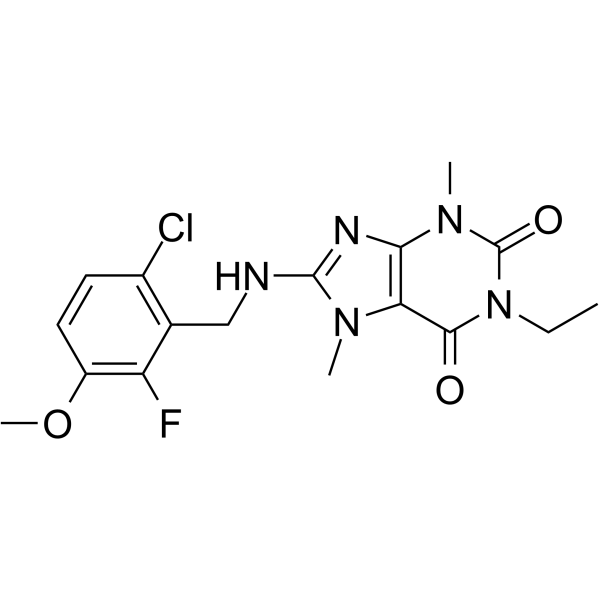Adenosine receptor inhibitor 1
Modify Date: 2024-01-19 12:23:42

Adenosine receptor inhibitor 1 structure
|
Common Name | Adenosine receptor inhibitor 1 | ||
|---|---|---|---|---|
| CAS Number | 2550400-52-5 | Molecular Weight | 395.82 | |
| Density | N/A | Boiling Point | N/A | |
| Molecular Formula | C17H19ClFN5O3 | Melting Point | N/A | |
| MSDS | N/A | Flash Point | N/A | |
Use of Adenosine receptor inhibitor 1Adenosine receptor inhibitor 1 is a potent and selective adenosine receptor (AR) inhibitor with Ki values of >1000, 68.5, >1000, >1000 nM for A1AR, A2AAR, A2BAR, A3AR, respectively. Adenosine receptor inhibitor 1 shows antinociceptive activity, anti-inflammatory effect and peripheral analgesic effect. Adenosine receptor inhibitor 1 has the potential for the research of cancer or neurodegenerative diseases[1]. |
| Name | Adenosine receptor inhibitor 1 |
|---|
| Description | Adenosine receptor inhibitor 1 is a potent and selective adenosine receptor (AR) inhibitor with Ki values of >1000, 68.5, >1000, >1000 nM for A1AR, A2AAR, A2BAR, A3AR, respectively. Adenosine receptor inhibitor 1 shows antinociceptive activity, anti-inflammatory effect and peripheral analgesic effect. Adenosine receptor inhibitor 1 has the potential for the research of cancer or neurodegenerative diseases[1]. |
|---|---|
| Related Catalog | |
| Target |
A1AR:>1000 nM (Ki) A2AR:68.5 nM (Ki) hA2B:>1000 nM (Ki) Adenosine A3 receptor:>1000 nM (Ki) |
| In Vitro | Adenosine receptor inhibitor 1 (compound 12d) (120 min) shows metabolic stability incubated with with 96.56 and 97.97% of the parent compound remained in the reaction mixtures after incubation with mouse (MLMs) and rat liver microsomes (RLMs), respectively[1]. |
| In Vivo | Adenosine receptor inhibitor 1 (20, 30, 40 mg/kg; i.p.) shows antinociceptive activity at a concentration-dependent mannner[1]. Adenosine receptor inhibitor 1 (20 mg/kg; i.p.) shows anti-inflammatory effect in carrageenan-induced edema model[1]. Adenosine receptor inhibitor 1 (5, 10, 20 mg/kg; i.p.) shows analgesic effect in mouse[1]. Animal Model: 18-26 g male albino Swiss mice (chronic pain induced by the administration of 5% formalin) [1] Dosage: 20, 30, 40 mg/kg Administration: I.p. Result: Showed antinociceptive activity with decreasesed the licking/biting time of the right hind paw of mice in response to the irritating chemical stimulus. Animal Model: 150-180 g male rats Wistar(carrageenan-induced edema model)[1] Dosage: 20 mg/kg Administration: I.p. Result: Showed anti-inflammatory effect with the inhibition of 23.3%, 54.2%, 66.0% at 1h, 2h, 3h, respectively. Animal Model: Mouse (induce pain of peripheral origin by injection of an irritant like phenylbenzoquinone or acetic acid in mice)[1] Dosage: 5, 10, 20 mg/kg Administration: I.p. Result: Showed peripheral analgesic effect with the significant decrease in the number of writhings by 32.9%, 54.9%, 82.0% at doses of 5, 10, 20 mg/kg, respectively. |
| References |
| Molecular Formula | C17H19ClFN5O3 |
|---|---|
| Molecular Weight | 395.82 |